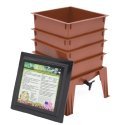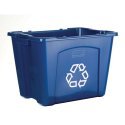Bacteria are found in literally every single habitat on the face of the earth and are one of the most essential forms of life on our planet. With seriously important roles to play and in composting; they cope with all kinds of conditions that threaten their survival, from extreme temperatures to lack of food supply, while coordinating between themselves a wide range of activities as if they were one collective being.
What is the role of bacteria in composting? More than that, what is bacteria in the first place, how do we even know what it does and how exactly does it do all this?
Some of those questions can get icky technical to say the least, but for those of you looking to find out more about the scientific aspects of bacteria, there is a plethora of good information at the library and online.
There is so much scientific info on bacteria that it will make your head spin with all kinds of Greek root words, Latin root words and the combination of words that explain behaviors, structures and shapes on a scale that is most of the time far smaller than the human eye can see on its own.
Historically speaking Thonius Philips van Leeuwenhoek, usually considered the father of microbiology, a Dutch tradesman, a scientist and the son of a basket maker; was the first human to observe what at the time he called animalcules in the year 1676 using a single-lense microscope of his own design.
The improved manner in which Dutch eye-glass makers of the 1600s were carrying out their business had been so creative as to invent some more useful items like the telescope and the microscope making it possible for Leeuwenhoek to see bacteria for the first time ever.
Blended with Leeuwenhoeks curiosity, it revolutionized the way science saw the physical world forever.
It would only be much later on, in 1828 that bacteria would be first called as such by Christian Gottfried Ehrenberg, after the Greek âáêôÞñéïí-á (bacterion a), meaning “small staff”.
Since then, the study of classifying bacteria has gone on and on, and grows even techier as the science of bacteriology advances throughout these long 330 or more years.
Sometimes, bacteria have taken on the role of criminal, sometimes the role of savior.
But to those of us who think practically, and in terms of how important a role bacteria have in composting and have continually had throughout the aeons, it is only reasonable to learn to respect those natural processes as much as possible for what they are; life.
Composting would not work without bacteria, not even vermicomposting would work without them, because without bacteria, there would not even be life on the planet as we know it.
These are ancient creatures, some of the very first forms of life on the planet eventually evolved into bacteria and they might even perhaps be responsible for the original formation of our atmosphere.
Some spiritual composters have even called them midichloreans (a word George Lucas derived from the endosymbiotic theory, yes a big concept), seeing them as a kind of omnipresent collective consciousness capable of healing the world.
That is a metaphysical issue that goes beyond the limits of this column and the fact that many people see them in this spiritual manner is already valid enough to mention since metaphorically speaking, they do a lot to add to our quality of life on this planet, without us even noticing, people accepting the fact as either spiritual or scientific is enough to respect their presence here at least.
They certainly are essential to the planet, cleaning up trash everywhere and producing a useful product, taking on a range of temperatures, surviving the strongest and most intelligent, while always in constant adaptation to environments and conditions.
Probably one of the most fascinating aspects of bacteria is their ability to survive through a kind of communal cooperation, quorum sensing, as in soil and on the surfaces of plants, where the majority of bacteria are bound in the form of biofilms (when bacteria attach to a surface in dense aggregations) also known as microbial mats.
The bacteria living in biofilms will commonly display a complicated network of cells and extracellular components arranging themselves optimally with secondary structures like microcolonies to better diffuse nutrients.
Quorum sensing is kind of a mystery to scientists, some use math to explain it, Kleiber’s Law, others use vitalist anthropomorphism (giving bacteria almost supernatural or human qualities), either way a person wants to rationalize it, these obviously independent organisms just spontaneously organize themselves through chemical exchanges (pheromones) that bind or induce certain genes into certain actions.
But basically what is happening with quorum sensing is, when a given community of bacteria (of the same species or not) undergo certain conditions (usually those that depend on survival, like energy depletion or temperature alteration), the different bacteria signal one another to do totally different jobs and in many cases, jobs that are not even evolutionarily species specific, always optimizing performance.
Friedrich Hayek called a “self-organizing system of voluntary co-operation” Catallaxy. And it is a phenomenon that seems to repeat itself over and over throughout earths communities, even the stock market.
As mysterious as this strange and complex optimization of bacteria is, it is exactly how composting can do its job so efficiently, it is why certain bacteria sacrifice themselves to create a kind of protective layer when quorum sensing starts to send out signals that conditions are going to become unfavorable soon.
The best metaphorical analogy is to say that they are acting like one collective organism, not a bunch of independent single-celled organisms, so where is the central planning?
Essentially, there is none, its just a mess of single-celled organisms that make themselves work together remarkably more efficiently well than even the most able or knowledgeable integrant of the community.
Who knows why that happens, it just does. Time and time again throughout human history and it presents itself as a very big theoretical challenge to both philosophers and scientists the world over. The fact that this catallaxy is the reason why composting with bacteria works is enough to explain how. Why it works, can be left to the reader to figure out.
Perhaps the way bacteria organize themselves could be studied as a form of biomimicry to help our society become more sustainable, since they certainly do have optimal performances during quorum sensing.
Now as for composting, there is a time when freshly added compost begins to pick up heat. Certain bacteria will survive and thrive between 0 and 40 degrees, but below and above that are considered extreme temperatures, thus these bacteria usually form endospores (little impervious shield walls inside the cell, filled with DNA and ribosomes), causing dormancy.
Thermophiles exist above 40 degrees and are what really break down bad news pathogens, making sure that they are completely destroyed during this stage of the hot pile.
Below zero degrees, there are psychrophiles that thrive at extremely low temperatures. Endospores are the way cells put themselves to sleep whenever conditions become too hostile and can just sit through changes until conditions become favorable.
Oscillating from 0-40 degrees and above, or back down to normal temperature and then maybe even slipping into such cold as that below zero. Bacteria use the collective knowledge and the power of quorum sensing to better organize their actions and survive until conditions become favorable once again.
Many bacteria help plants to process nutrients in soil, many help breakdown organic compost into CO2 to return to the atmosphere, many help destroy harmful pathogens and overwhelmingly, each and every single one of these independent organisms has an incredibly important role to play as members of a collective, members of the great cycle of life.
Bacteria work together in ways that we as of yet, do not even fully understand, while in this dance of life, dance of energy and dance of movement; one bacterium can hold the key to an entire community of composting bacteria and maybe even working as gods of the earth.





